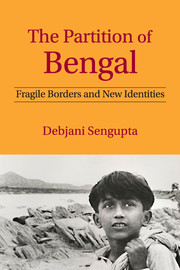Book contents
- Frontmatter
- Dedication
- Contents
- Acknowledgements
- Introduction
- 1 The Calcutta Riots in Representations and Testimonies
- 2 Noakhali and After: History, Memory and Representations
- 3 Colony Fiction: Displacement and Belonging in Post-Partition Bangla Fiction
- 4 From Dandakaranya to Marichjhapi: Refugee Rehabilitation in Bangla Partition Fictions
- 5 The Partition's Afterlife: Nation and Narration from the Northeast of India and Bangladesh
- 6 Uncanny Landscapes and Unstable Borders: Politics and Identity in Geo-Narratives of the Partition (2005–10)
- Bibliography
- Index
1 - The Calcutta Riots in Representations and Testimonies
Published online by Cambridge University Press: 18 December 2015
- Frontmatter
- Dedication
- Contents
- Acknowledgements
- Introduction
- 1 The Calcutta Riots in Representations and Testimonies
- 2 Noakhali and After: History, Memory and Representations
- 3 Colony Fiction: Displacement and Belonging in Post-Partition Bangla Fiction
- 4 From Dandakaranya to Marichjhapi: Refugee Rehabilitation in Bangla Partition Fictions
- 5 The Partition's Afterlife: Nation and Narration from the Northeast of India and Bangladesh
- 6 Uncanny Landscapes and Unstable Borders: Politics and Identity in Geo-Narratives of the Partition (2005–10)
- Bibliography
- Index
Summary
When I now read descriptions of troubled parts of the world, in which violence appears primordial and inevitable, a fate to which masses of people are largely resigned, I find myself asking, Is that all there was to it? Or is it possible that the authors of these descriptions failed to find a form – or a style or a voice or a plot – that could accommodate both violenceandthe civilized willed response to it?
Amitav Ghosh, The Imam and the Indian: Prose PiecesIn 1946, Gopal Pantha, a notorious mastaan (goon) of north Calcutta, was 33 years old. Everybody called him by the nickname Pantha, a goat, because he ran a meat shop in College Street (in the Boubazar area). Although he was the leader of a gang of neighbourhood thugs, Gopal did not belong to any criminal underclass of the city. His Brahmin upper caste family (his patrilineal name was Mukherjee) had links to the Congress party and had contributed their share to the militant nationalist movements of the 1930s. On the morning of 16 August 1946, he left for his shop as usual but when he heard about the trouble he came back to his locality.
Muslim League volunteers were marching with long sticks in their hands. From Boubazar More to Harrison Road you could hear their slogans, ‘Larke lenge Pakistan.’ Then I heard that two goalas (dairymen) had been killed in Beliaghata and riots have started in Boubazar.
He organized his ‘boys’ because he thought ‘it was a very critical time for the country; the country had to be saved. If we become a part of Pakistan we will be oppressed … so I called all my boys and said this is the time we have to retaliate, and you have to answer brutality with brutality …
They armed themselves with small knives, swords, meat-choppers, sticks and rods, while Gopal had two American pistols tucked at his waist. He had procured these as well as some grenades from the American soldiers quartered in Calcutta in 1945. ‘If you paid two hundred and fifty rupees or bought them a bottle of whiskey the soldiers would give you a .45 and a hundred cartridges.’ As soon as the news of rioting spread his group of vigilantes swelled.
- Type
- Chapter
- Information
- The Partition of BengalFragile Borders and New Identities, pp. 36 - 67Publisher: Cambridge University PressPrint publication year: 2015



